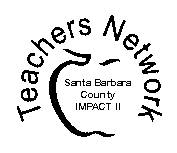The TeachNet Project sponsored with major funding by the AT&T Learning Network,
seeks to improve student achievement by providing training, grants, networking and resource sharing to teachers at four of the Teachers Network affiliates nationwide.

Funding Provided by Alias Wavefront
![]()
Building
Videos to Build Language
How it Works:
I have slowly grown a set of Mac computers in the
classroom from 1 (which ran a FirstClass BBS for interschool
weather data sharing) to a mix of 9 older and new machines, all
accessing the internet via T1 line, and 3 having digital video
input and editing capabilities. Students sit in groups of 4 at
lab tables... no desks, and it is very common for individuals to
go to a computer to input a bit of data or writing to a piece of
work or class template and then return to the group.
However, using video as a learning tool represents a
number of challenges. Every minute of video is time intensive,
both in terms of planning and filming, and editing. Meanwhile,
issues of the processing power of computers and number of
machines need to be considered.
Here's two examples of how video is a part of my
classroom.
1. Capture and archiving of lessons and lab
activities.- In this case, we are experimenting with students
capturing essential elements of science experiments- teacher
instruction and student activities- which are quickly edited and
then saved for future use by students who either missed that
day, or want review. They are saved on cd-roms.
- Management- I have a "Go To" table which
rotates about every week. These students will learn and do
whatever special skill or need arises, and become the resident
experts for the rest of the class. If video production of an
activity is called for, it is naturally their task to work it
out in group.
2. ELD Class- An extended activity which involves these
language learners picking a short "story" to tell via
video. I have a scene diagramming template which they must fill
out completely in their work group before using video.
Standards
-Knows that the design process is a series of
methodical steps for turning ideas into useful products and
systems
-Knows the common features and uses of desktop publishing
software
- Prewriting: Uses prewriting strategies to plan written work
(e.g., uses graphic organizers, story maps, and webs; groups
related ideas; takes notes; brainstorms ideas; organizes
information according to type and purpose of writing)
-Represents concrete information as explicit mental pictures
- Understands techniques used to convey messages in visual media
Estimated
Class periods to Complete
4-6 50 min. periods
Software or materials used
Video capture cards in a G3 mac, along with
Strata videoshop and Premier to edit. Fortunately, there are now
3 firewire equipped iMac computers, which directly access our Canon ZR10 mini DV camera.
Apple has free iMove 2 software which shifts time and attention
from the software to the thinking and editing process...
wonderful improvement! It is possible to do similar work with a
VHS or 8 mm camera and using 2 vcr's to record only key video
from the raw originals.
The Students -
My middle school program is a mix of science and
English Language Development. Approximately 90% of our students
have English as their second language. There is no reason to let
language limitations result in low levels of cognitive
enthusiasm, and I've found over the years that regular access to
a range of technologies- from computers to hand held sensors,
still shots to video, brings out the best in most students.
Overall Value-
Our students have developed unconscious refinement in nuances of
video media.... commercial advertisers know and exploit this. A
key reason to use any technology with learners is to move them
progressively from passive learners to active producers.
Students can create vivid and meaningful short subjects on video
that engage a wide range of their abilities- clarity of
descriptive language, editing for clarity and impact, visual
literacy development and musical talents as well. The work is
memorable for the students, and they beg for more chances to
work, especially students who are interested in issues of sound
and music tracks.
Tips for teacher-
Don't be in a hurry!
Each element of the scene is envisioned and describe in clear,
simple language. This work is spaced out and paced within other
classroom activities, so that access to camera and computer
follows their readiness, and you can work with groups
intensively on different elements of their projects.
Jeff Foote been a science and English Language Development teacher at a jr. high school for 9 years. He administrated a FirstClass electronic bulletin board system (bbs) for science teachers and students. Science data, photos, student work samples and challenge questions ran through the system. A key element was the ability to archive shared work. Since that participation, he's been a district and county schools tech mentor for numerous years, state leadership team member for online science resources, and been directing staff development projects in science, English Language development, and technology. Current projects include piloting LessonLab, online videotape analysis tool for teacher instruction, and Beyond the Classroom, another NSF project helping teachers integrate science, language, and technology standards into units of instruction.
Jeff Foote
II/USP Plans Facilitator
Guadalupe Union Schools,
(805) 343-1951 (805) 343-6931 fax
Central Coast Science Project Co-director,
Teacher!
